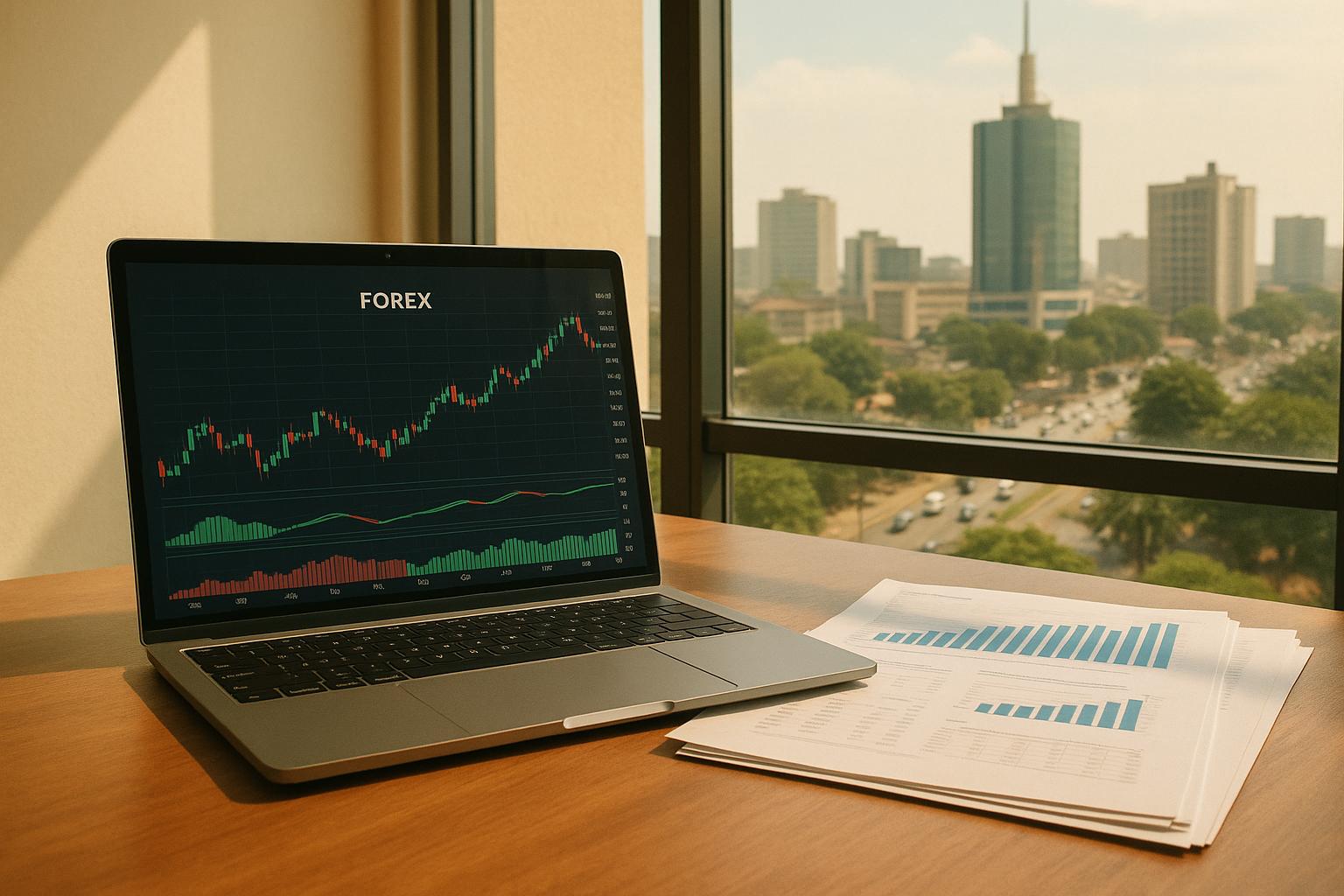Monte Carlo simulation is a method used to test trading strategies by running thousands of scenarios based on historical data. Unlike standard backtesting, which provides a single outcome, this technique generates a range of possible outcomes by reshuffling historical data. For Nigerian traders, it’s especially useful due to the naira’s volatility and the risks associated with unregulated brokers. By simulating various scenarios, traders can better understand potential risks, returns, and drawdowns.
Key Takeaways:
- What it does: Models a spectrum of outcomes to assess strategy performance.
- Why it matters: Helps Nigerian traders manage risks in volatile markets like USD/NGN.
- How it’s done: Shuffles historical data, tests variables like position sizing, and runs thousands of simulations for accuracy.
- Key metrics: Maximum drawdown, Value at Risk (VaR), probability of ruin, and profit distribution.
Monte Carlo simulation provides traders with deeper insights into strategy performance, enabling informed decisions about risk management and capital allocation.
Core Concepts and Methods of Monte Carlo Simulation
Understanding Market Uncertainty and Randomness
Financial markets are anything but predictable, and the Nigerian forex market provides a vivid example with the naira’s frequent swings against major currencies. Monte Carlo simulation tackles this unpredictability by leaning into randomness. Instead of trying to pinpoint exact outcomes, it models a spectrum of possibilities, acknowledging the influence of random variables. By assigning random values to uncertain factors and running the model thousands of times, it generates a distribution of potential results. For Nigerian traders working with USD/NGN pairs, this could mean factoring in variables like exchange rate volatility, shifts in interest rates, or changes in economic policy. Unlike fixed projection methods, this approach offers a more dynamic and realistic perspective, making it a valuable tool for managing risk in Nigeria’s ever-changing trading landscape.
Key Monte Carlo Methods in Trading
Monte Carlo simulation builds on the concept of randomness by using statistical techniques to test how resilient a trading strategy is under different conditions. Some of the most widely used methods include resampling (bootstrap), randomised testing, and permutation.
- Resampling shuffles historical trading data to create new sequences, helping traders determine if a strategy’s performance is based on skill or just luck.
- Randomised testing takes this further by tweaking trade entry and exit points. For instance, if a trade typically starts at 9:00 AM, the entry time might be adjusted within a 15-minute window to see how sensitive the strategy is to timing.
- Permutation methods rearrange the order of trades entirely, generating alternative equity curves to expose patterns like drawdowns or periods of underperformance.
These methods allow traders to stress-test their strategies under various scenarios, offering insights into how they might perform in real-world conditions.
Required Parameters for Running Simulations
To effectively run Monte Carlo simulations, traders need to define several key parameters:
- Initial Capital: This serves as the foundation for calculating returns, drawdowns, and other risk metrics.
- Position Sizing: Determines how much capital is risked on each trade. This could be a fixed percentage (e.g., 2% per trade) or tied to market volatility, which is especially relevant when managing currency risks in USD/NGN accounts.
- Stop-Loss Levels and Profit Targets: These set the boundaries for risk and reward. For example, a strategy using a 50-pip stop-loss and a 100-pip profit target would model outcomes based on these limits.
- Number of Simulations: The reliability of results improves with more iterations. While 100 simulations might provide a rough idea, running 1,000 or more iterations ensures greater statistical accuracy.
- Historical Data Quality: High-quality historical data is essential for realistic outcomes. For Nigerian traders, this means accounting for wider spreads and the naira’s heightened volatility.
- Trading Costs: Include all associated costs like commissions, fees, spreads, swaps, and slippage.
Step-by-Step Process of Running a Monte Carlo Simulation
Preparing Trade Data from Backtesting
Start by backtesting your trading strategy using historical data, focusing on price, volume, and market conditions. For Nigerian traders working with USD/NGN, it’s essential to use data that captures the naira’s volatility, especially during economic instability or policy shifts.
Define clear entry and exit rules, risk limits, and technical indicators. For instance, your strategy could involve entering long positions when the 20-day moving average crosses above the 50-day moving average on the USD/NGN pair, with a stop-loss set at 2% and a profit target at 4%. Use backtesting software to simulate trades, which will generate a trade list. This list should detail entry and exit dates, profit or loss in naira, and trade durations. Afterward, assess performance metrics like total returns, win rate, and maximum drawdown to ensure the data is ready for simulation. A well-organized trade list is the foundation for running a successful Monte Carlo simulation.
Simulating Hypothetical Trading Outcomes
Once the trade data is prepared, randomize it to create alternative trading scenarios. Monte Carlo simulation works by shuffling the order of trades, producing different sequences that result in varied equity curves with unique drawdown patterns and performance metrics. For example, if you backtested over two years, one simulation might show strong trades occurring early, while another could cluster them later.
Using simulation software, you can run thousands of iterations, each generating metrics like total return, maximum drawdown, losing streaks, and recovery times. This process helps you identify whether your backtest results were genuinely robust or simply benefited from a lucky sequence of trades. Given the naira’s sensitivity to market changes, this analysis is particularly important for Nigerian traders. These varied scenarios provide a broader understanding of your strategy’s potential performance under different conditions.
Analysing and Aggregating Simulation Results
The final step is to evaluate the simulation results to gain insights into your strategy’s performance and risk profile. The output typically includes statistical distributions of returns, confidence intervals for key metrics, and probability estimates for various outcomes. For example, while your backtest might show a 150% return (₦1,500,000 profit on a ₦1,000,000 starting capital), the simulation could reveal a return range from -20% to +300%, suggesting that the backtest performance might have been unusually fortunate.
Pay special attention to drawdown analysis. Backtest results can sometimes underestimate potential losses. For instance, while your backtest might show a maximum drawdown of ₦300,000, the simulation could reveal that most scenarios experience drawdowns below ₦450,000, with some exceeding ₦600,000. This is critical for traders dealing with the naira’s frequent fluctuations. Additionally, review streak lengths to understand the likelihood and impact of prolonged losing periods, helping you better prepare for the risks involved in live trading.
Key Metrics and Insights from Monte Carlo Simulation
Important Metrics for Nigerian Traders
Monte Carlo simulation provides a range of metrics that can help Nigerian traders better understand the potential performance of their strategies, especially in the face of the naira’s volatility and unpredictable market conditions.
Maximum Drawdown Distribution gives a detailed view of possible losses. For example, while a backtest might show a maximum drawdown of ₦200,000, Monte Carlo simulation could reveal that 95% of scenarios result in drawdowns below ₦450,000, with extreme cases reaching ₦620,000 or more. Studies suggest that worst-case simulated drawdowns can hit up to 3.1 times the backtested figure.
Value at Risk (VaR) estimates the potential loss over a specific time frame with a certain level of confidence. For instance, a 5% VaR of ₦150,000 for one month means there’s a 5% chance of losing ₦150,000 or more during that period. This is particularly relevant for Nigerian forex traders, given the naira’s depreciation and the highly volatile forex market.
Probability of Ruin calculates the likelihood of completely depleting your trading account. For example, if a simulation indicates a 15% probability of ruin over two years, it highlights the risk of total account loss. This is especially important when considering that 71% of retail investor accounts reportedly lose money trading CFDs.
Consecutive Losing Streak Analysis focuses on the potential for extended losing streaks. While a backtest might show a maximum of 5 consecutive losses, Monte Carlo simulation could reveal scenarios with 12 or more consecutive losses. This insight helps traders prepare both financially and emotionally for tough periods.
Profit Distribution Analysis explores the range of possible returns rather than relying on a single outcome. For example, even if a backtest predicts a 120% annual return (₦1,200,000 profit on ₦1,000,000 capital), Monte Carlo simulation might show returns ranging from -30% to +200%, with a median around 45%. This illustrates the variability in potential outcomes.
These metrics not only provide a deeper understanding of risk but also highlight the limitations of traditional backtesting methods, offering a more dynamic perspective on strategy performance.
Comparison with Standard Backtesting Metrics
When compared to traditional backtesting, Monte Carlo simulation offers a broader and more realistic understanding of trading risks and outcomes. Here’s how the two approaches differ:
| Metric | Standard Backtesting | Monte Carlo Simulation | Key Advantage |
|---|---|---|---|
| Maximum Drawdown | Fixed: ₦200,000 | Range: ₦150,000 – ₦620,000 | Shows potential for larger losses |
| Total Return | Fixed: 120% | Range: -30% to +200% | Reflects a wider range of outcomes |
| Win Rate | Fixed: 65% | Range: 58% – 72% | Accounts for variations in trade sequences |
| Consecutive Losses | Maximum: 5 trades | Range: up to 15+ trades | Prepares for longer losing streaks |
| Risk Assessment | Based on one historical sequence | Thousands of simulated scenarios | Offers a more thorough risk evaluation |
Monte Carlo simulation is particularly useful for Nigerian traders, as it factors in the unpredictable influences of economic policies, fluctuating oil prices, and shifts in global market sentiment.
"The purpose of Monte Carlo Simulation is to detect lucky backtests and misleading performance metrics before risking real capital." – Build Alpha
This approach helps traders determine whether their strategy is genuinely reliable or simply benefited from favorable conditions in backtesting. Armed with this information, traders can make better decisions about position sizing and risk management.
sbb-itb-05e2063
Practical Applications and Limitations of Monte Carlo Simulation
Improving Strategy Performance and Risk Management
Monte Carlo simulation plays a crucial role in testing Nigerian trading strategies before actual money is put on the line. By simulating a range of possible outcomes, traders can determine if their backtest results are reliable or just the result of chance.
Position Sizing and Capital Allocation benefit significantly from these simulations. Instead of sticking to fixed position sizes based on a single backtest, traders can use simulation data to adjust risk per trade and make informed decisions about how to distribute capital. For instance, simulations can show how diversifying across currency pairs like USD/NGN, EUR/NGN, and GBP/NGN can reduce portfolio risk compared to focusing on just one pair.
Stress Testing for Market Conditions is another advantage. Traders can simulate scenarios like oil price shocks or changes in Central Bank policies to prepare for market volatility. By inputting strategy parameters, they can generate key outcomes such as the ‘Most Likely,’ ‘Best,’ and ‘Worst’ case results.
While Monte Carlo simulation offers these benefits, it’s not without its challenges.
Limitations and Assumptions of Simulations
Monte Carlo simulation has some notable limitations that Nigerian traders should keep in mind. Its accuracy relies heavily on high-quality historical data, which might not always account for unexpected market shifts.
Overfitting and Market Evolution are significant concerns. Simulations may fail to capture the complexity of evolving market dynamics or emerging trends, as markets often behave in ways that deviate from historical patterns.
Another limitation is the Exclusion of Human Factors. Simulations don’t account for individual decision-making behaviours, which can introduce unique risks that models fail to predict.
Given these constraints, it’s critical to use Monte Carlo simulation in conjunction with other risk management tools.
Integrating Monte Carlo Simulation into Naira Forex Trading

To maximise the benefits of Monte Carlo simulation, traders should integrate it into a broader trading framework. A Multi-Tool Approach is particularly effective. Instead of relying solely on simulation results, traders should validate strategies through forward testing and live simulations, which can help address the shortcomings of backtesting.
Gradual Implementation is another key aspect. Starting with a Monte Carlo analysis of existing strategies can help traders identify weaknesses and make adjustments to position sizing and risk management before moving into live trading.
Regular Updates are also essential in a constantly changing market. Running simulations periodically – such as every quarter or after major market events – ensures that strategies stay relevant and aligned with new conditions.
At Naira Forex Trading, we recommend combining Monte Carlo simulation with both fundamental analysis of Nigerian economic indicators and technical analysis of currency pairs. This blended approach offers a broader view of trading possibilities while recognising the limitations of relying on any single method.
"The Monte Carlo simulation is valuable in risk management as it allows for modelling potential market fluctuations in FX rates. By running multiple simulations, FX dealers and traders can quantify risks, examine worst-case scenarios, and prepare for volatility." – Natalyia Forbes, Dealer Support Administrator at Equals Money
Ultimately, Monte Carlo simulation is a tool to enhance decision-making, not a replacement for sound trading judgment. Nigerian traders who combine these insights with strong market knowledge, economic understanding, and disciplined risk management will be better equipped for long-term success.
Build Alpha – Monte Carlo Simulation Basics

Conclusion
Monte Carlo simulation offers Nigerian forex traders a powerful way to evaluate and refine their trading strategies. By simulating thousands of market scenarios based on specific trading parameters, it provides insights that go beyond what traditional backtesting can reveal.
One of its standout strengths is its ability to address market uncertainty. As HowToTrade.com puts it: "The Monte Carlo Method is an automated technique that is used to project a trader’s different profit & loss outcomes. Through running Monte Carlo Simulations, individuals can estimate the efficacy of their trading strategies". This feature is especially useful when trading volatile currency pairs like USD/NGN, where market conditions can shift quickly. Such insights help traders develop stronger risk management techniques.
Monte Carlo simulation enhances risk management by analysing factors like maximum drawdown distributions, ruin probabilities, and expected return ranges. It complements backtesting by offering a broader perspective on potential outcomes. This helps traders make better decisions about position sizing and set realistic expectations for their capital.
Beyond individual strategy testing, this method can also strengthen oversight and protection for traders. By stress-testing strategies under various market conditions, traders can make smarter choices about broker selection and capital allocation. It’s a tool that supports informed decision-making at every level of trading.
However, success with Monte Carlo simulation requires discipline. Traders need to integrate it with tools like Value at Risk (VaR) and Conditional Value at Risk (CVaR), conduct regular reviews, and work with well-capitalised, regulated brokers. While simulations provide valuable insights, they are not a substitute for sound trading judgement and market expertise.
At Naira Forex Trading, we believe Monte Carlo simulation is a must-have for serious traders. When combined with a solid understanding of Nigerian economic indicators and technical analysis, it gives traders a more complete view of the forex market. This approach can boost confidence and improve risk management.
Ultimately, consistent trading success comes down to understanding the full range of possibilities. By recognising these potential outcomes, Nigerian traders can make more confident and informed decisions in the ever-changing forex market.
FAQs
How does Monte Carlo simulation help Nigerian traders handle the naira’s volatility in forex trading?
Monte Carlo simulation offers Nigerian traders a practical way to tackle the naira’s unpredictable behaviour by simulating various market scenarios. This technique allows traders to test how their strategies might hold up under different conditions, including sudden and extreme price swings.
With this method, traders can gauge potential risks and losses, set achievable profit goals, and build solid risk management plans. For forex traders navigating Nigeria’s often volatile currency landscape, Monte Carlo simulation serves as a powerful tool to make smarter, more confident trading decisions.
How does Monte Carlo simulation differ from standard backtesting when evaluating trading strategies?
Monte Carlo simulation and standard backtesting serve distinct roles when it comes to evaluating trading strategies. Standard backtesting relies on a single set of historical data to gauge how a strategy would have performed in the past. On the other hand, Monte Carlo simulation creates multiple hypothetical market scenarios derived from historical data. This approach helps traders examine a wide range of potential outcomes and understand how a strategy might behave under different market conditions.
Monte Carlo simulation provides a deeper look into risk by showcasing the variability and stability of a strategy. This makes it especially useful for navigating unpredictable markets like forex. By testing strategies against various scenarios, traders gain better insights into potential risks, enabling them to make more confident and informed decisions.
How can Nigerian traders ensure accurate and reliable Monte Carlo simulations for USD/NGN trading?
To run accurate Monte Carlo simulations for USD/NGN trading, Nigerian traders need to start with reliable, up-to-date data that mirrors the realities of the Nigerian forex market. This means gathering historical exchange rates along with key economic indicators like oil prices and inflation trends. It’s also essential to factor in Nigeria-specific influences, such as monetary policies and the global oil market, to ensure the simulations reflect real-world conditions.
Another important step is backtesting models with actual market data to confirm that the simulations align with historical trends. Traders should also keep simulation parameters updated to match current market dynamics and incorporate sensitivity analyses to test different scenarios. These steps help account for the unique volatility and economic drivers in the Nigerian forex market, making the simulations more dependable.

